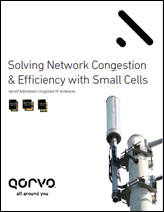10 Important Milestones on the Road to 5G
July 26, 2017
 Built on the foundation of 4G LTE, 5G, the next-generation mobile network,
will be here before we know it, ushering in a new wave of disruptive
technological innovation with ubiquitous high-speed connectivity. 5G will
transform entire industries and enable resilient, high-speed, high-volume
Internet connectivity from practically anywhere and on any device or
sensor.
Built on the foundation of 4G LTE, 5G, the next-generation mobile network,
will be here before we know it, ushering in a new wave of disruptive
technological innovation with ubiquitous high-speed connectivity. 5G will
transform entire industries and enable resilient, high-speed, high-volume
Internet connectivity from practically anywhere and on any device or
sensor.
In this blog post, we identify milestones for you to watch for as 5G becomes a reality.
#1: Leveraging Current 4G Cellular Infrastructure
The 5G future does not require a "rip and replace" approach to network infrastructure. In fact, many of today's 4G innovations will enable the 5G networks of the future for a broad range of applications. An all IP-based network core is an important requirement for 5G networks, and is already a goal that mobile carriers are aggressively working toward in the 4G cellular infrastructures.
Tip: You can find out more about 4G infrastructure innovations in Chapter 4
of 5G RF
For Dummies®.
#2: Greatly Expanding the Available Spectrum
Some use cases in 5G access networks will require very wide contiguous
carrier bandwidths. To support these wide contiguous bandwidths, new carrier
frequencies below 6 gigahertz (GHz), as well as millimeter wave (mmWave) will
be required.
 #3: Expanding Carrier Aggregation
#3: Expanding Carrier Aggregation
Carrier aggregation (CA) combines multiple LTE component carriers (CCs)
across the available spectrum for higher data rates and lower latency. CA
technology is evolving rapidly with current CA deployments supporting 5 CA in
the downlink direction and 2 CA in the uplink direction.
#4: Increasing Densification
 Densification using small cell technology enables carriers to provide more
users with lower latency, better mobile device battery life, and expanded
cellular coverage.
Densification using small cell technology enables carriers to provide more
users with lower latency, better mobile device battery life, and expanded
cellular coverage.
#5: Deploying Massive Multiple Input/Multiple Output (MIMO)
Massive MIMO, consisting of hundreds and even thousands of active antenna
elements, will work together to provide vastly more mobile capacity, coverage,
and reliability for the 5G future.
 #6: Enabling Vehicle to Everything (V2x)
Communication
#6: Enabling Vehicle to Everything (V2x)
Communication
Today, autonomous ("driverless" or "headless") vehicles, are increasingly in the news — unfortunately, often the subject of a sensational crash or accident. However, as 5G technology continues to develop, autonomous vehicles will become as commonplace as traditional vehicles with drivers that don't use their heads! These vehicles will become less expensive, more popular, and — most important — much safer.
Smart cars with human drivers will also leverage 5G technology to improve
vehicle safety and efficiency, as well as the overall driving experience.
#7: Providing More Options with Fixed Wireless Access
Fixed Wireless Access (FWA) provides subscribers with more alternatives for
connecting to the cloud using wireless broadband data communication to connect
two or more fixed locations.
#8: Using Your Mobile Phone as a Hub
If you think your life revolves around your smartphone today, wait until
you get your first 5G smartphone! With high-speed mobile broadband access and
truly ubiquitous coverage, the 5G smartphone will enable devices to
communicate directly with each other, without routing the data paths through a
network infrastructure.
#9: Active Antenna Systems
Active Antenna Systems (AAS) is an advanced base station platform that
meets carrier extended mobile broadband services and massive full-dimensional
MIMO technologies.
#10: Low Latency: Key for AR, VR, V2x, and Mission Critical
Mission-critical services requiring very high reliability, global coverage, and very low latency, will become more native to support 5G infrastructure. Latency may be more important than throughput in some applications.
Want to learn even more about the future of 5G? Download your free copy of Qorvo's 5G RF For Dummies e-book.
– Excerpted with permission from John Wiley & Sons, Inc., from 5G RF For Dummies.
Have another topic that you would like Qorvo experts to cover? Email your suggestions to the Qorvo Blog team and it could be featured in an upcoming post. Please include your contact information in the body of the email.
